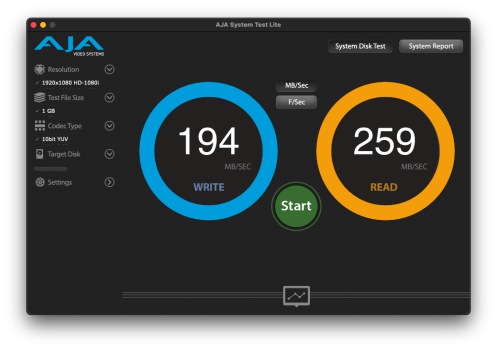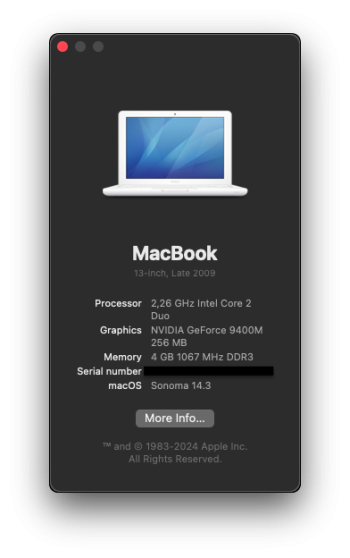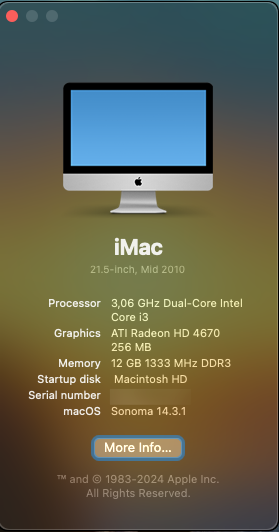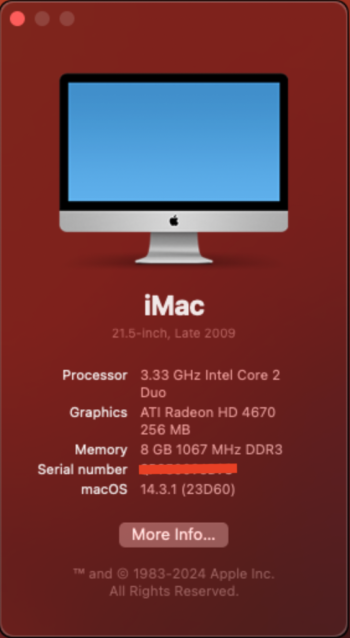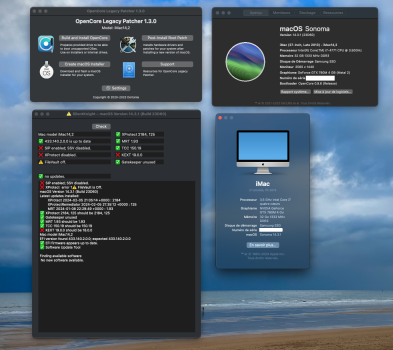If you lower the resolution to 1152x720 you will notice that it is not as fluid as it is supposed to be. And it happens across all the other parts of the system@JoinMeinHeaven Here is a new video done with screenFlow vs qicktime. The recording is always slightly slower than what I see on screen and it's always been that way even when I recorded with a supported OS. Probably because of the Fusion drive vs a pure SSD.
View attachment 2347702
Got a tip for us?
Let us know
Become a MacRumors Supporter for $50/year with no ads, ability to filter front page stories, and private forums.
macOS 14 Sonoma on Unsupported Macs Thread
- Thread starter dhinakg
- WikiPost WikiPost
- Start date
- Sort by reaction score
You are using an out of date browser. It may not display this or other websites correctly.
You should upgrade or use an alternative browser.
You should upgrade or use an alternative browser.
- Status
- The first post of this thread is a WikiPost and can be edited by anyone with the appropiate permissions. Your edits will be public.
Select the volume to boot from, hold down the shift key during initial phase of boot process. I had a similar problem with my late 2013 MBP 11,3 and the installation/upgrade process completed after that. I was using the 1/30 OCLP 1.4.0 (n) but 1.3 is probably the same.
Usually people who install nightlies look in the changelog to see if there is an important fix for them.I think there have been at least 1 or 2 updates since I asked. So that's why I asked again to see if they added anything.
Remember our little conversation about the whats min Ram specs are for modern MacOS'?The KDK for macOS 14.3.1 now available, here: https://github.com/dortania/KdkSupportPkg/releases Scroll down a bit.
Just updated my Macbook 6,1 late 2009 using 4GB to Sonoma 14.3 using 1.4.0. It works reasonably well with performing mundane things like browsing the web, writing emails, notes calendar, printer server on the local network.
The actual bottle neck rather seems to be the processor and the 256mb GPU ram, given the numerous (sometimes unnecessary?) tasks running in the back ground. Swap is around 250mb after a few hours moderate usage while having 1 or 2 apps open.
Could you use it as a daily driver? Perhaps. Keyboard and Bluetooth are also working again with the latest OCLPn. That really begs the question: How often is hardware update actually necessary? I got too many iPhones, iPads and Macs lying around which are still working (well) with default OS. Thats a shame.
Attachments
Installed succesfully 14.3.1 on my mini late 2012 intenal Crucial main SSD partition.
With 14.4 beta after succesfull installation i can't root patch cause OCLP asks me admin privilegies password (OCLP not Sonoma) that i don't know
With 14.4 beta after succesfull installation i can't root patch cause OCLP asks me admin privilegies password (OCLP not Sonoma) that i don't know
Last edited:
Thanks everyone for this great work. I just came back to macOS (OSX) after a long time where I just ran FreeBSD on my old Mac. Since the old lady finally got replaced it was time to give her a new chance on macOS.
Not entirely sure why they are putting this on their website https://github.com/dortania/OpenCore-Legacy-Patcher/blob/main/SOURCE.mdI think there have been at least 1 or 2 updates since I asked. So that's why I asked again to see if they added anything.
"Additionally, these binaries should not be used without first consulting the CHANGELOG."
I'll just hold off for now until I need something different. I just thought it would be easier to ask here because sometimes people can give more specific answers to questions than looking at a changelog by itself.Not entirely sure why they are putting this on their website https://github.com/dortania/OpenCore-Legacy-Patcher/blob/main/SOURCE.md
"Additionally, these binaries should not be used without first consulting the CHANGELOG."
I think it's because all the admin users become standard users after installation of 14.4. They can't do anything, as patching the system with OCLP, and they can't create a new admin user. A system without admin user is useless.Installed succesfully 14.3.1 on my mini late 2012 intenal Crucial main SSD partition.
With 14.4 beta after succesfull installation i can't root patch cause OCLP asks me admin privilegies password (OCLP not Sonoma) that i don't know
Apparently, memory use is hardware and configuration dependent. This Mini7,1 is running the current Firefox with one tab open to this page, the CPU is idling at 1% and RAM use is well over 6 GB out of 16GB. Any comparison S/B based on somewhat equal Macs. 😉Remember our little conversation about the whats min Ram specs are for modern MacOS'?
Just updated my Macbook 6,1 late 2009 using 4GB to Sonoma 14.3 using 1.4.0. It works reasonably well with performing mundane things like browsing the web, writing emails, notes calendar, printer server on the local network.
The actual bottle neck rather seems to be the processor and the 256mb GPU ram, given the numerous (sometimes unnecessary?) tasks running in the back ground. Swap is around 250mb after a few hours moderate usage while having 1 or 2 apps open.
Could you use it as a daily driver? Perhaps. Keyboard and Bluetooth are also working again with the latest OCLPn. That really begs the question: How often is hardware update actually necessary? I got too many iPhones, iPads and Macs lying around which are still working (well) with default OS. Thats a shame.

MBP 15'retina late 2013 with Kepler (11,3) updated via OTA from 14.3 + OCLP 1.3.0 to 14.3.1 + OCLP 1.3.0 pswd key-in slow but work in login field then I did post-root-patch (without safe boot mode). After that MBP reboot normally and login OK.
How is 2012 iMac 27" on macOS Sonoma 14.3.1?Another success with Sonoma 14.2 b3 with OCLP Nightly (build f1210de) on my iMac 13,2 27" late 2012.
Login loop now fixed. Thanks Devs!
View attachment 2317389
iMac 13,2 27" (late 2012)How is 2012 iMac 27" on macOS Sonoma 14.3.1?
Installed 14.3.1 OTA over 14.3 using 1.4.0n OCLP.
No discernible issues noted on my machine.
I installed 14.4 beta2 on an iMac 13,2 via USB Thumb Drive. When I reached login screen, I had no problems entering administrative password, other than having to use a wired USB keyboard and mouse. Thereafter I took a chance and applied 1.4.0n OCLP patches. I also had no issue entering admin password when OCLP requested credentials. Once machine rebooted, after applying patches successfully, there was graphic acceleration, but Bluetooth, WiFi and Ethernet were not functional.I think it's because all the admin users become standard users after installation of 14.4. They can't do anything, as patching the system with OCLP, and they can't create a new admin user. A system without admin user is useless.
Last edited:
I have 17" MacBook Pro 5,2 with 8 GB RAM, C2D at 3.06 GHz, and a Samsung SSD.Remember our little conversation about the whats min Ram specs are for modern MacOS'?
Just updated my Macbook 6,1 late 2009 using 4GB to Sonoma 14.3 using 1.4.0. It works reasonably well with performing mundane things like browsing the web, writing emails, notes calendar, printer server on the local network.
The actual bottle neck rather seems to be the processor and the 256mb GPU ram, given the numerous (sometimes unnecessary?) tasks running in the back ground. Swap is around 250mb after a few hours moderate usage while having 1 or 2 apps open.
Could you use it as a daily driver? Perhaps. Keyboard and Bluetooth are also working again with the latest OCLPn. That really begs the question: How often is hardware update actually necessary? I got too many iPhones, iPads and Macs lying around which are still working (well) with default OS. Thats a shame.
It is a dual graphic card model, a 256 MB NVIDIA GE force 9400M (like yours) and a 500 MB NVIDIA GE for 9600M.
It run 14.3 without issues, at speeds compatible with "daily driver use", until I applied Sonoma 14.4 beta1, and then beta2 updates, just to push the envelope. It boots into login screen on beta2, but keyboard and trackpad are not functional, hence, I can't login to see if it actually would function. Hoping an OCLP version will help there, eventually.
The SSD is divided into 4 volumes, Sonoma, Ventura, Monterey and Catalina. The latter three are fully functional.
While I mainly use the MacBook Pro 5,2 as a "test bed", to see how long I can upgrade OS via OCLP, most applications run at speeds compatible with daily use. That includes GIMP (some versions still run on non-meta machines, albeit only at casual speeds), Libre Office and most Apple productivity application, with exception of Maps which requires metal capability.
I agree that many older Apple computers would function just fine with modern software, although I do recognize that there are limits dictated by the price of effort needed to maintain software compatibility, security requirements, etc.
27" iMac 13,2 (late 2012), 1TB Fusion Drive. Updated to 14.3.1 via OCLP 1.4.0n. No issues noted.
Thank you to developers for great work.
Thank you to developers for great work.
You can’t compare memory usage between systems who don’t have the same amount of installed RAM.Apparently, memory use is hardware and configuration dependent. This Mini7,1 is running the current Firefox with one tab open to this page, the CPU is idling at 1% and RAM use is well over 6 GB out of 16GB. Any comparison S/B based on somewhat equal Macs. 😉
View attachment 2348122
macOS uses more memory when more memory is available, for caching or keeping alive some process or less compressing.
I don’t understand why people continue to try to install 14.4 beta.
We all know it’s not working until OCLP developers fix it!
Unless you are participating to dev, it’s a waste of time !
We all know it’s not working until OCLP developers fix it!
Unless you are participating to dev, it’s a waste of time !
MBP11,2: macOS 14.3.1 + OCLP 1.4.0n ✅ – OTA-Update over 14.3.
Haven't deleted the kexts and booting in normal mode was ✅Remove some kexts from /Library/Extensions before updating, else booting in normal mode will stall. Boot in safe mode in this case. - Then apply root patches and normal booting (and all the rest, wifi etc.) will work.
Yes, still the same 😢 and no info about this from developers – also editing of portrait photos crashes app if clicking on edit button. More Info: https://discord.com/channels/417165963327176704/1192473370177064970The (for me) slight disturbance of Photos crashing immediately when Memories clicked ("Rückblicke" in my German version) is still there.
Hi, It's running really well on 14.3.1, with no discernible issues, upgraded OCLP to 1.4.0 Nightly, from 2 weeks ago, before starting the update.How is 2012 iMac 27" on macOS Sonoma 14.3.1?
I upgraded from 14.3 with OTA update of 13.37 GB as I didn't revert the boot patches.
Last edited:
Late 2009 iMac, 10,1
OTA Update from 14.3
Using Open Core Legacy Patcher v1.4.0n, and during update, a USB Keyboard and Mouse, connected via a USB 3.0 hub, with backwards compatablity.
After commencing OTA update, OCLP prompted the download & Installation of the required KDK.
Post install patches, and all working fine.
OTA Update from 14.3
Using Open Core Legacy Patcher v1.4.0n, and during update, a USB Keyboard and Mouse, connected via a USB 3.0 hub, with backwards compatablity.
After commencing OTA update, OCLP prompted the download & Installation of the required KDK.
Post install patches, and all working fine.
Attachments
Last edited:
Register on MacRumors! This sidebar will go away, and you'll see fewer ads.


